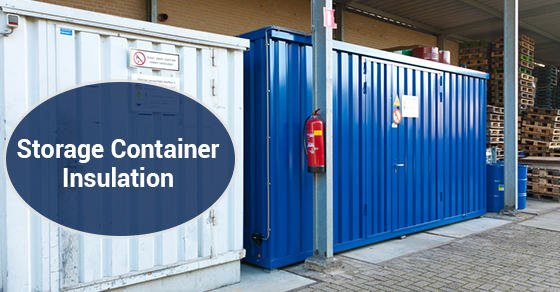
Winters can be so much fun, but they certainly are…well, cold! Often very cold. If you decided to get yourself a storage container to keep your belongings safe or to use it as an extra living space (hello, that fantasy art studio or workroom!), the thought of how to keep it warm during our long and frigid winters, may have crossed your mind.
If you went the rental storage container route, insulation can be requested as part of your rental specs. That’s easy. If, however, you bought a standard storage container, you may have discovered that the nasty weather is a problem. It could be that the cold conditions are putting your belongings at risk of damage, or your art studio may be unusable as the numbing cold chases away all inspiration, but in any case, it’s time to get that container insulated.
There are a number of options available for insulating a storage container. The main types of insulation that can be used for a storage container are spray foam, traditional roll insulation, foam board and insulated panels.
Spray Foam Insulation to the Rescue
If you’re residing in an area that’s not only prone to freezing temperatures but also to rain, you should consider applying spray foam insulation. Spray foam will not only keep frigid temperatures at bay, but will also create a seamless vapour barrier—critical to preventing condensation, the source of the dreaded mold. With the spray foam method, you can get insulation into every nook and cranny in the corrugation of the walls of your storage container, protecting it from condensation, mold and steel corrosion.
To Roll or Not to Roll
The insulation method that’s likely more familiar to you is the traditional roll method—you may have already used it with your attic or basement insulation project. This option, however, does require some additional work, and it may reduce the space inside the storage container because you will need to put in framing. Since roll insulation does not create a seal like spray foam insulation, you will still have to install a vapor barrier to stop potential condensation.
The Pros And Cons Of Foam Boards And Panels
While both the spray foam and the roll insulation are relatively easy to work with, they do require an extra step because after the insulation is applied, you will need to deal with the interior walls. With foam board insulation, however, there is no need for interior coverage. These precut foam boards come with a laminated panel on one side that serves as your interior wall. It’s an all-in-one insulation option, which is quite convenient. Still, some DIY homeowners warn that this installation process can get a bit tricky, and you need to be pretty handy before attempting it.
Similar to the foam board insulation method is the installation of SIPs—structural insulated panels. These panels are much stronger than foam insulation boards, and provide both insulation and support to the walls. This might be a great option for storage containers that are intended as a living space.
If you decided to forgo the rental storage container option and purchased one outright, insulating it may be critical to protecting your climate-sensitive, valuable materials. And if you modified the storage container into a living space, insulation will make it livable all year round. Still, if you are not thrilled by the idea of doing the insulation work, the good news is that even if you already purchased a standard uninsulated storage container, some companies will actually come and pick it up and install insulation for you. Problem solved!

Leave a Reply